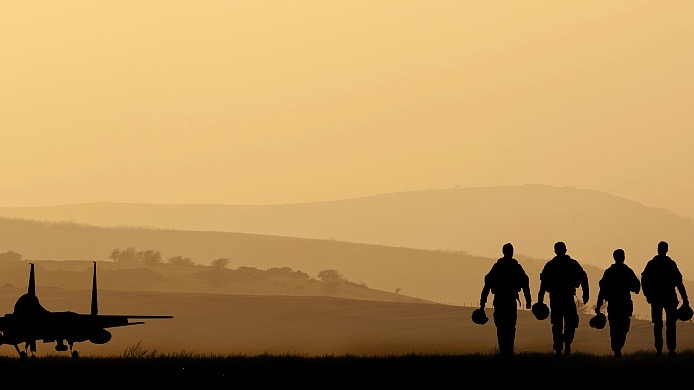The North Atlantic Treaty Organization (NATO) has long reigned supreme in the global military arena. By Thursday it will be celebrating its 70th birthday. Since the end of the Cold War, the septuagenarian has grappled with its legitimacy amid international vicissitudes.
Over the past few years, discord sown within the transatlantic relationship has been tearing apart the fabric of the military alliance.
In a legitimacy quagmire
To military and international relations observers, whether the existence of NATO still has meaning has been a lingering question for over two decades. Its ideological opponent – the Warsaw Pact which represented the Eastern bloc – was ended months before the dissolution of the Soviet Union in 1991.
During the Cold War era sandwiched between the end of World War II and the break-up of the Warsaw Pact, the Eastern and Western blocs had a reason to exist in building up their own defenses for an arms race. The end of the Cold War, however, removed that impetus.
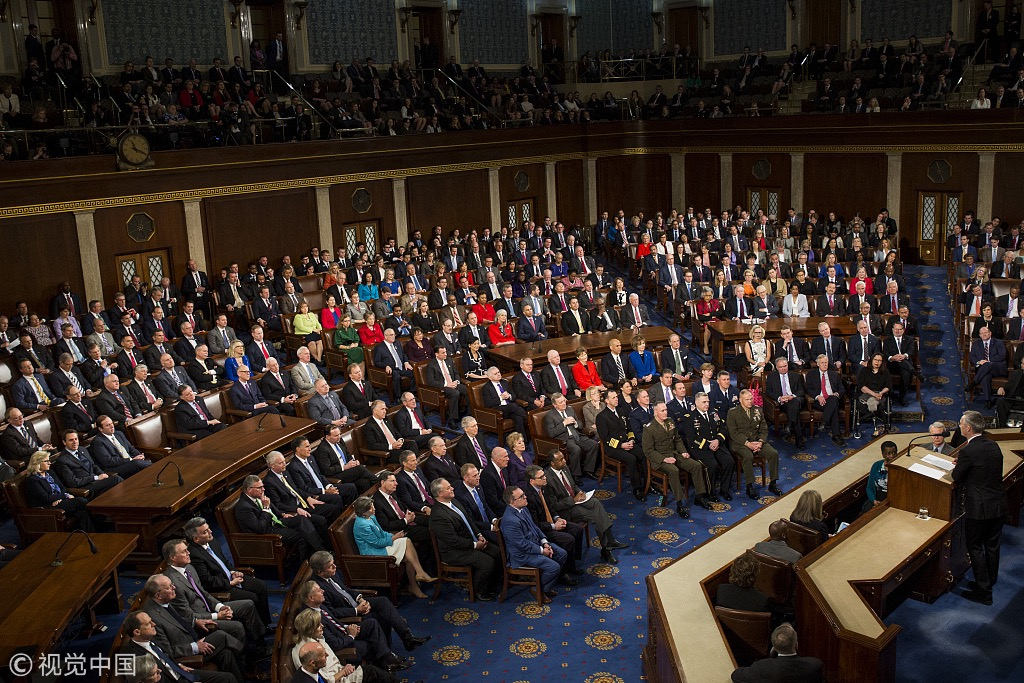
NATO Secretary General Jens Stoltenberg speaks during a joint meeting of U.S. Congress on Capitol Hill in Washington, DC, April 3, 2019. /VCG Photo
NATO Secretary General Jens Stoltenberg speaks during a joint meeting of U.S. Congress on Capitol Hill in Washington, DC, April 3, 2019. /VCG Photo
“NATO has long lost its relevance as a military alliance. Since the early 1990s, it has been seeking transformation with non-traditional security threats including terrorism and humanitarian crisis emerging,” Wang Yiwei, director of the Center for European Studies at Renmin University of China, told CGTN.
However, the path of transformation is chock-full of barricades. The era when two worlds are at odds with each other is over, and a new epoch when humans have to address common challenges such as epidemics, climate change, pollution and hollowing out of certain industries has dawned. NATO, which was founded to tackle traditional security challenges, has failed to reposition itself at a time when the international order that has been refined for over 70 years is at stake.
Furthermore, Beijing, toward which the world center is tilting, already tops Washington's list of security threats, but its European alliance has yet to follow suit. Without a military rival, NATO still struggles to justify its legitimacy.
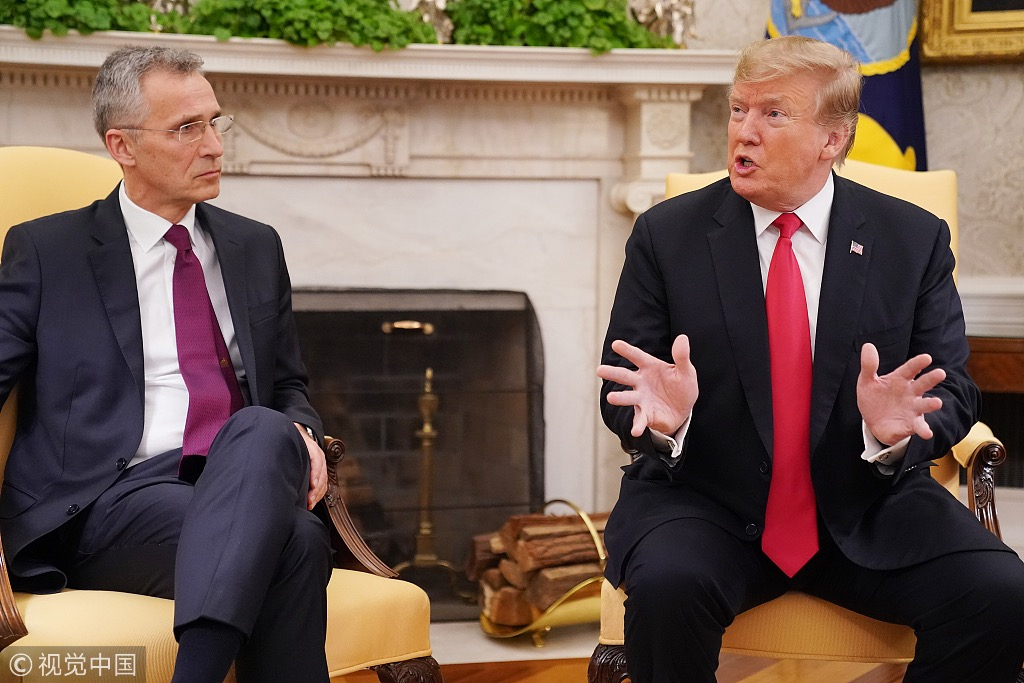
Secretary General Jens Stoltenberg (L) and U.S. President Donald Trump talk to reporters in the Oval Office at the White House in Washington, DC, April 2, 2019. /VCG Photo
Secretary General Jens Stoltenberg (L) and U.S. President Donald Trump talk to reporters in the Oval Office at the White House in Washington, DC, April 2, 2019. /VCG Photo
Transatlantic distancing under Trump-led U.S.
The financial crisis in the West had tanked European military spending on NATO. By the end of the Cold War, European members undertook 34 percent of the bloc's military expenditure; now the proportion has declined to barely over 20 percent. Regarding the GDP share spent on defense, Europe also saw a drop from under 3 percent in 1989 to 1.95 percent in 2017. In the same year, the U.S.'s 685.9-billion-U.S.-dollar contribution dominated those from other NATO members, each of which contributed only dozens of billions of U.S. dollars.
U.S. President Donald Trump, the acrimonious critic of NATO, has been hounding his European allies to increase spending on one of the U.S.'s oldest alliances. Calling NATO “obsolete,” he's latched onto the notion that each NATO member must pay at least 2 percent of its GDP on the bloc's military by 2024. During a meeting with NATO Secretary-General Jens Stoltenberg, who was in Washington to mark the 70th anniversary of the organization, Trump hammered Europe to contribute more.
Another plan under discussion in the White House is for its European allies to pay the full cost of stationing American troops on their military bases, plus an additional 50-percent fee.
While antagonizing close allies over military expenditures, Trump pulled the U.S. out of the Intermediate-range Nuclear Forces (INF) treaty, plunging Europe into another dangerous arms race with Russia. The shadow of the Cold War has re-emerged.
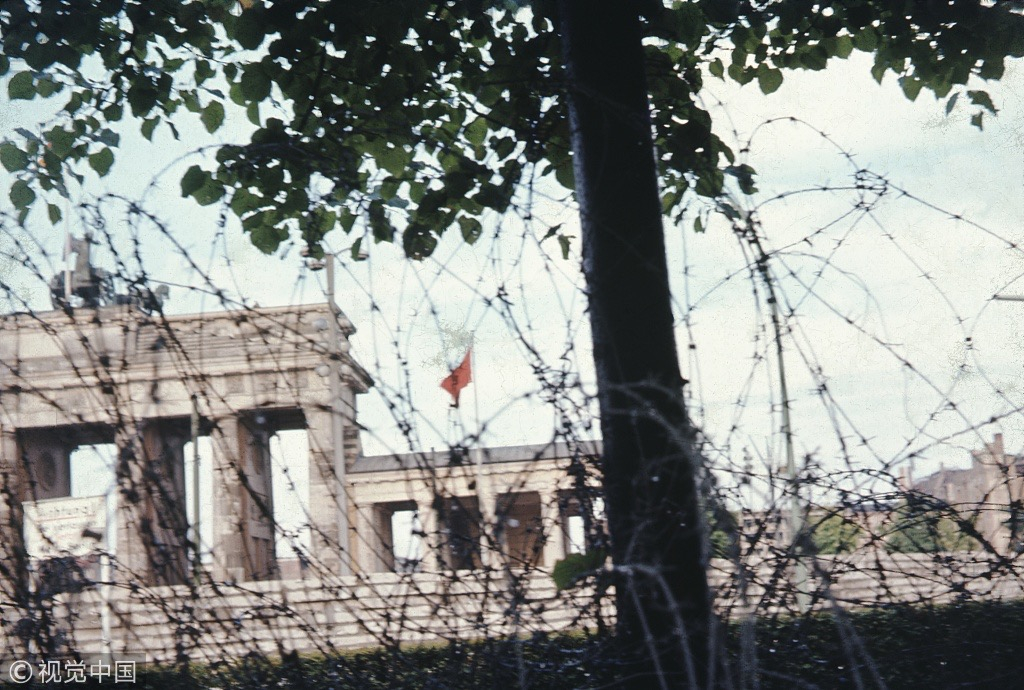
A view of East Berlin, seen through barbed wire along the border between East Berlin and West Berlin during the Cold War, Germany, 1965. /VCG Photo
A view of East Berlin, seen through barbed wire along the border between East Berlin and West Berlin during the Cold War, Germany, 1965. /VCG Photo
How about a European Army?
Given the fading relevance and resilience of NATO, a withering U.S. commitment, and the transatlantic distancing, Europe is looking for its own way out. French President Emmanuel Macron called late last year for the creation of a European Army – a military apparatus that operates only on European command and is dedicated to the defense of the European continent. German Chancellor Angela Merkel applauded the vision: “The times in which we could completely depend on others are, to a certain extent, over.”
“The European Army was envisioned basically out of Europe's concern that its destiny and that of NATO are dominated by Americans,” said Wang, also a Jean Monnet Chair professor, adding that the U.S. not merely provided over 70 percent of NATO funds but also its equipment, goals and “brain” so that Europe feels like a dwarf in security and consequently politics. That's a key roadblock in European integration.
Actually, the idea of a pan-European defense bloc dates back to the 1950s when a European Defense Community was proposed as part of the Brussels Treaty, which nonetheless was aborted after the U.S. objected.
Decades later, former French Prime Minister Alain Juppé's vision of a European Army consisting of 350,000 soldiers capable of acting independently in 1996 and European Commission President Jean-Claude Juncker's similar call in 2015 remain fantasy.
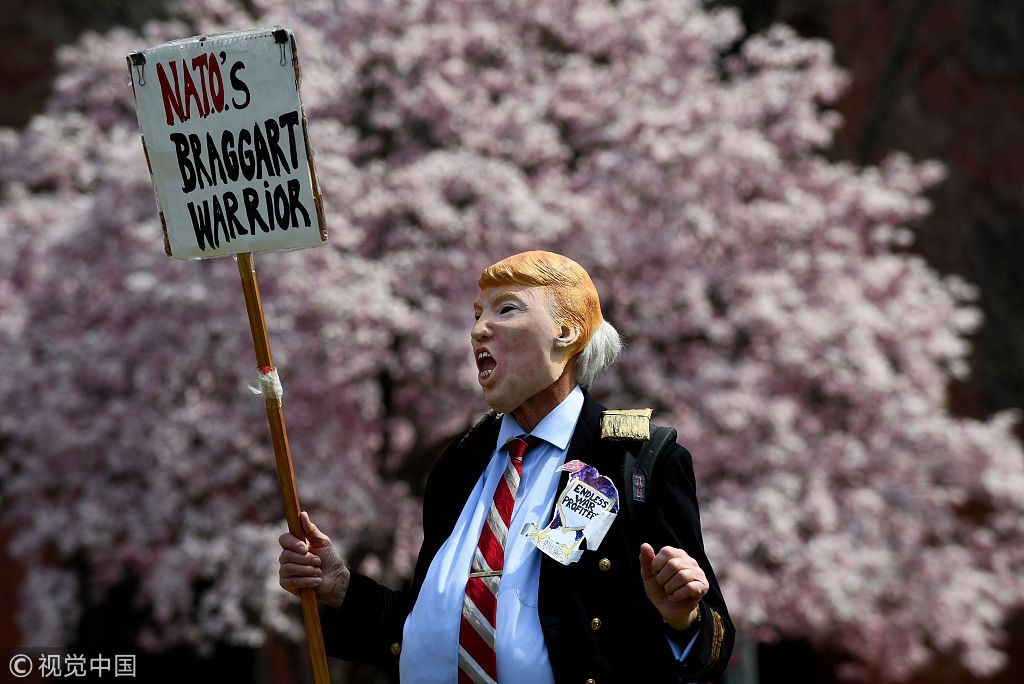
Activists rally in Lafayette Square to protest ahead of the 70th anniversary of the summit meeting of NATO, in Washington, DC, March 30, 2019. /VCG Photo
Activists rally in Lafayette Square to protest ahead of the 70th anniversary of the summit meeting of NATO, in Washington, DC, March 30, 2019. /VCG Photo
Will NATO die?
It appears the 29-country bloc is hanging by a thread at 70. Most alliances in history died young – a study by the Brookings Institution in 2010 revealed that only 10 out of 63 major military alliances over the previous five centuries lived beyond 40 and the lifespan of collective defense alliances averaged 15 years.
NATO is, in all ways, long lived. In fact, the United States needs NATO more than the other way around. Without NATO, the U.S. would not have the military clout to become a global hegemon. Europe, meanwhile, relies on the cohesiveness of the organization to act as a counterweight to ideological and strategic rivals.
Merkel also said that the proposed European army is intended to act as an “intervention unit” that will supplement NATO instead of replacing it, while Macron envisions a force capable of carrying out offensive and humanitarian missions.
Although the path ahead is arduous for the long-standing NATO, as long as there is a rival – real or imagined – that the member states can coalesce against, it is difficult to conceive of it completely dissolving. Or as Wang said to CGTN, “The U.S. and Europe, lovers one minute and enemies the next, are doomed to continue playing the NATO game.”

